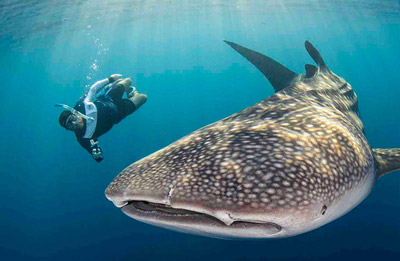
Whale Sharks in the Gulf of California
 We used satellite-linked radio telemetry to document the geographic and vertical movements and thermal habitats of whale sharks in the Sea of Cortez and as they migrated into the north Pacific Ocean. This was the first time satellite tracking was used on whale sharks to study the living and growth pattern of this incredible species. Of 17 sharks tagged between 1994 and 1996, six dispersed widely in the Sea of Cortez during 12–39 days of tracking. Four others left the Sea of Cortez and ranged extensively in the north Pacific Ocean. Indeed, one whale shark migrated to the western north Pacific Ocean, covering over 13,000 km in 37 months of tracking.
We used satellite-linked radio telemetry to document the geographic and vertical movements and thermal habitats of whale sharks in the Sea of Cortez and as they migrated into the north Pacific Ocean. This was the first time satellite tracking was used on whale sharks to study the living and growth pattern of this incredible species. Of 17 sharks tagged between 1994 and 1996, six dispersed widely in the Sea of Cortez during 12–39 days of tracking. Four others left the Sea of Cortez and ranged extensively in the north Pacific Ocean. Indeed, one whale shark migrated to the western north Pacific Ocean, covering over 13,000 km in 37 months of tracking.
For almost 30 years we worked with collaborators in the Indian, Pacific, and Atlantic oceans at locations including the Philippines, the Maldives, the Galapagos, the Gulf of California, the Gulf of Mexico, Indonesia and West Papua, Kenya and Western Australia. Over the decades we tackled some of the basic questions about whale shark population biology, biogeography, ecology, and behavior. This world-wide sampling allowed us to test the DNA of whale sharks, and we found the only inherited gene clusters (haplotype) distinction was between the Atlantic and Indo-Pacific populations. This global pattern of shared haplotypes in whale sharks argues for broad international approaches to conserve Earth’s largest fish.
